This site is best
viewed at 800x600
and 16 bit color.
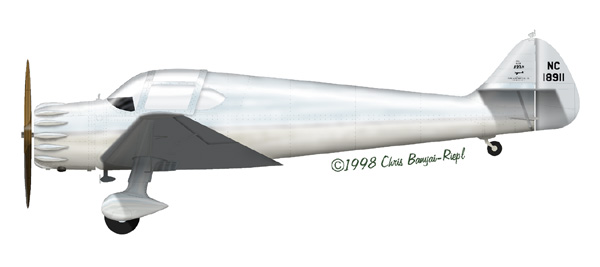
The Ryan SC Sport Coupe
After the barnstorming era of the 1920's, general sport aviation became very popular. In the 1930's the success of the Ryan ST Sport Trainer led Claude Ryan on to build something for the general aviator that was starting to take to the skies. With more family flying taking place, Ryan decided that an enclosed cockpit would be the way to go, and set about designing a three to four place aircraft. Working on his experience from the production of the Ryan ST, the Ryan SC, for Sport Coupe, quickly came into being. Not one to go with a regular design, Ryan incorporated several new and unique features. Since the SC was being built solely for the civilian marketplace, Ryan was able to build the SC lighter than its Curtiss competition, which was built to military load factors to increase versatility. This ultimately led to a better performance and lower maintenance costs. One of the pioneering features of the SC was in its undercarriage. It incorporated a simple single-leg unit enclosed in a pant, while the other planes of that time were still using multi-leg units enclosed in a large fairing. Another simplicity feature was in the cockpit. Instead of the standard car-door type of entrance, Ryan used a simple rollback canopy that covered both the front and rear seats, making it very easy to get in and out of the plane.
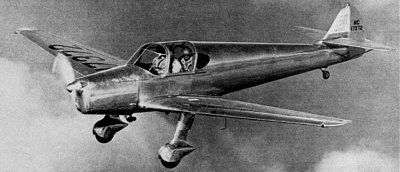
The original Ryan SC with the Menasco engine.
The most innovative feature, though, had to be the wing. By incorporating several old ideas into one wing, Ryan was able to come up with something unique enough to be patented. Instead of the normal multi-spar arrangement being used at the time, Ryan went with a single spar system, with a metal skin wrapped around the leading edge to provide the required torsional stiffness. This resulted in a much lighter wing which in turn resulted in better performance, especially compared to the competition. Another wing feature was the introduction of the belly flap. It was designed solely for use as a drag-inducing device to keep the airspeed down on steep landing approaches. Normal flaps were not used on the SC. Initially, the 150hp MENASCO C-4S inverted four-cylinder engine, which was also being used in the RYAN ST-A, powered the SC. A big effort was made to use standard components and basic construction throughout to minimize problems and maximize serviceability by the general public.
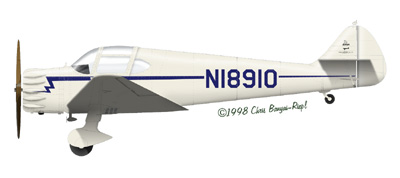
The first flight of the Ryan SC took place on May 11, 1937. The performance of the SC was as good as expected, and there were no problems discovered in the flight characteristics or design. The evaluation for government certification went smoothly, and was approved on September 15, 1937. While waiting for the government certification, the Ryan SC was being put through a tough shakedown process, during which the shortcomings of the Menasco engine were made apparent. These same shortcomings were also apparent in the military versions of the Ryan ST, and led Ryan to choose a radial engine instead, the Warner "Super Scarab" 145hp seven-cylinder engine. Being a radial engine instead of an inline, the front end of the SC had to be redesigned to fit it, and the federal certification process repeated. Flight tests showed that a slight change in the wing root/fuselage fairing was needed, but other than that, it performed very well. With the radial engine, the empty weight increased by about ten pounds, but the top speed and gross weight stayed the same. The new government certification for the Warner-engined SC (abbreviated SC-W) was issued on October 31, 1937.

The SC-W showing the new cowling for the Warner engine.
Production of the SC-W was anticipated even before the first one had flown, and an initial run of 25 was prepared for. After a nationwide promotional tour, Ryan upped that number to 50, and sales started in 1938. For a mere $6,885 (in 1938 dollars), the customer got a comfortable plane that was easy to fly and fairly quiet, too. Standard equipment included soundproofing, leather interior, plus stuff that was considered luxury items at the time, such as navigation lights, starter, and brakes. Extra equipment such as a radio and additional instrumentation could boost the price to over $7,500. Unfortunately, this extra equipment had a downside, as every additional pound of equipment meant one less pound of useful load. This resulted in the usual aspect of having either a four-place plane with no luggage, or a 2-place plane with decent luggage capacity. The smooth lines and strong Warner engine gave the Ryan SC great performance, with a top speed of 150mph in level flight. Cruise speed was advertised as 145mph at 5,000ft, with a landing speed of a mild 45mph.
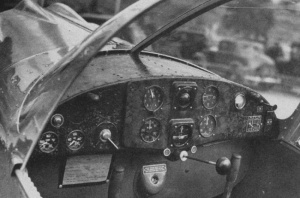
Original instrument panel of the SC-W.
While the demonstration tour showed great promise for the SC, only 12 were actually built, including the prototype. The Ryan SC fell victim to the imminence of the Second World War and the incredible success of the Ryan ST. With so many orders coming in from around the world for this excellent military trainer, the Ryan commercial efforts were quickly cancelled and shifted over to the more lucrative ST. Out of the 11 production machines, only one left the United States and went to Brazil. The rest remained in the US. During the war, civil flying was very restricted, so little was seen of the Ryan SC. Five of them did get a brief spot in a movie, though, appearing as Japanese fighters in the 1942 film "Wake Island". Another wartime use of the Ryan SC was that of Civil Air Patrol anti-submarine missions. Five SC-Ws were fitted with bomb racks and depth charges, and one was even credited with finding and damaging a U-boat. One SC-W was appropriated by the Army and given the designation L-10 (serial number 42-107412) and was used for general liaison work.
As the Second World War was winding down, small plane manufacturers anticipated a potential boom in civilian sport aviation. With a large number of military aviators returning to the US, several companies such as Piper, Aeronca, and Erco reopened old production lines of 1940 designs. Ryan, for some reason, did not resume production of the SC, even though it would have been a logical choice given the competition. Instead, they took over the North American "Navion" in 1947, eventually producing over 1200 of these before the Korean war again shifted Ryan production to military aircraft.
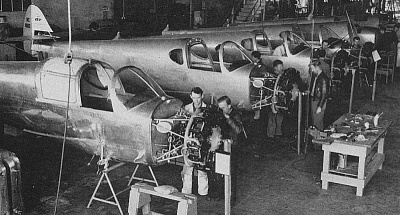
Ryan SC-Ws under construction.
The last of the unique civil aviation design of Claude Ryan was slowly destined for the scrap heap, where most planes ended up after their usefulness expired. It was only through the antique aviation boom in the early 1950's that these unique planes were saved. Over the years, the few SC-Ws changed hands frequently, and by the late 1980's there were still nine flying. Some had been re-engined with more modern powerplants such as the Continental E-185, but most of them remained true to the original design. The most difficult part in maintaining the Ryan SC-W is finding parts for the old Warner engine, which went out of production shortly after WWII. Other changes include the addition of modern radios and newer tires, as the original Goodyear "Airwheels" are no longer made. Even with these changes, the Ryan SC-W is still a great plane to fly, and the number remaining 50 years later attest to that point.
![]() Ryan guidebook : fifty years of Ryan airplanes by Dorr B. Carpenter
Ryan guidebook : fifty years of Ryan airplanes by Dorr B. Carpenter
![]() Ryan Sport Trainer by Dorr B. Carpenter
Ryan Sport Trainer by Dorr B. Carpenter
